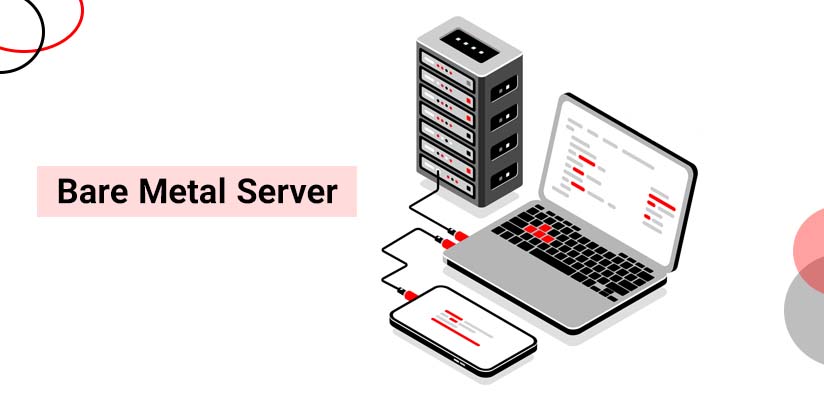
What is bare metal? Well, to put bare metal meaning into simple words, a bare metal server is a physical computer that is intended to operate dedicated services continuously for long periods of time. It is very sturdy, long-lasting, and dependable. Bare metal servers are a singular environment, which means that the physical resources of a single server cannot be shared by two or more tenants.
Because of this physical isolation, bare metal servers don’t suffer from the “noisy neighbor” problem that plagues virtual environments. The predictability of performance is one of the major advantages of this isolation. As a result, bare metal servers have the most secure environment, which makes them ideal for processing huge amounts of data.
What are bare metal features? Direct connection to the server and the ability to use all underlying hardware configurations are other important advantages. Let’s have a look at the bare metal features later. You get a guest OS on top of a hypervisor on top of real hardware when you create a virtual machine (VM). Only the guest OS and the administration interface used to build the VM would be accessible to you as a user. Physical hardware would be unavailable to you.
A bare metal server, on the other hand, gives you complete access to the underlying architecture. When it comes to building your own platform to host a service or application, the advantage is that you have more choices. This brings us to another important issue.
In contrast to the virtual environment, which requires a minimum of one extra layer of software – a Type 1 hypervisor – bare metal servers do not need the usage of multiple layers of software.
In daily usage, this suggests there is one less software implementation for both you and your actual hardware. As a result, you may anticipate improved performance. It’s worth noting that in a virtualized environment, bare metal renters may build VMs on top of bare metal.
Once you buy a bare metal server, you can personalize it in whatever manner you desire, just as you can design your own home. You don’t have to cope with “noisy neighbor”.
A public cloud multi-tenant virtualized environment, on the other hand, is similar to renting an apartment. The screaming of the next-door youngsters drives you insane, and there’s nothing you can do about the odd odor in the corridor.
Identifying and Defining Bare Metal Environments
Physical hardware underpins all environments, whether virtualized or bare metal. As a result, even virtualized systems (such as the public cloud) have real hardware underneath them.
The phrase “bare metal” is often used to distinguish a physically dedicated server from a cloud infrastructure or contemporary cloud hosting models. Bare metal servers are those in a data center that aren’t shared by numerous customers.
It’s essential to keep in mind that even a virtualized environment has real hardware. However, the shared hosting deployment approach, which is common in virtual environments, distinguishes itself by allowing end-users to interact with virtual resources rather than bare metal.
A bare metal server’s sole tenant has root privileges. Additional software choices are available, which are not feasible with a bare metal hypervisor.
What are Bare Metal Features? Why Use Bare Metal Servers?

Small to medium companies seeking for a cost-effective cloud provider that can rapidly automate and expand their resource allocation would benefit from using bare metal dedicated servers.
According to several analysts, the usage of bare metal servers is declining in comparison to alternative hosting choices. This kind of server, on the other hand, is still a popular choice in many sectors. The platform’s unique features enable it to provide top levels of efficiency, power, and security.
Banking and financial services, health care, and government are three industries that have historically relied on dedicated hosting services and colocation. Furthermore, bare metal is ideal for mission-critical, high-intensity workloads like data analytics or database applications. Because of the increased performance levels, render farms and video encoding activities are examples of projects that utilize this option rather than virtualized servers. So, why use bare metal servers?
If you need to read more about Bare Metal Server, check our recent blog “What Is Bare Metal Server?”
Utilizing Bare Metal Servers

Bare metal systems are most often used in industries that need the greatest levels of data protection, world-class performance, and accurate data processing. This industry will continue to expand as the need for storage increases in tandem with the growth of big data. The bulk of use is anticipated to come from large businesses in these industries. Until 2016, the SMB sector accounted for a larger share of bare metal infrastructure consumption. Advertising and new technical developments are anticipated to be the primary drivers of market growth.
So, why would a company buy a bare metal server? What are the features of bare metal servers?
– Performance
You can tune the running on a single physical server to your specific workloads, ensuring that it meets your needs.
– Reliability
Because you’re not sharing system resources with other users like a hypervisor server, you won’t experience the “noisy neighbor effect.”
– Security
A bare metal server provides a greater degree of security and privacy than a virtual machine because it physically isolates your data, programs, and other resources.
– Billing in the Utility Style
Pay just for what you use, right down to the minute, to keep expenses low. Pricing and invoicing depending on usage.
Conclusion
Are bare metal servers beneficial? Bare metal servers are still an important part of many businesses’ IT systems. Using this setting has many benefits. Bare metal represents the pinnacle of modern technology. By utilizing the provider’s experience across all professional aspects of maintaining such infrastructure, you may rapidly expand worldwide when hosting bare metal with an Infrastructure-as-a-Service provider.
This implies you’ll be able to cluster your resources worldwide at a low cost. The ability to hybridize your network by integrating your bare metal and virtual assets is another benefit of bare metal. Growing companies should think about bare metal as a long-term data storage and transport option. When it comes to pure power, structural flexibility, and customization possibilities, there is no better option.










Leave a Reply